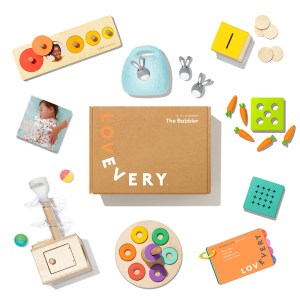Throwing and rolling and flinging, oh my! How to support your baby’s love of making balls move

Throwing objects is a natural part of play and an early lesson in cause and effect. We get it: you don’t want to teach your baby to start hurling heavy objects all over your home, but we aren’t talking about a perfect underhand pitch or a coordinated overhand throw. These first throws are more of a fling.
Creating safe ways to practice helps build skills that your baby is naturally excited to explore.
Somewhere between 9 and 12 months, your baby may accidentally throw an object. They’ll be shaking their hands, trying to release the ball from their grip, and will realize the ball has been flung to a distance, bouncing and rolling.
Your toddler may start to throw a ball underhand while sitting, with their arm down at the side and their palm up, sometime around 13 to 16 months.
By around 18 months, your toddler will likely throw a ball forward while in a supported standing position. Supported means standing while hanging onto a table with one hand, or with you holding on to their waist or hips.
Give your toddler many opportunities to throw appropriate objects at appropriate times.
Here are some ideas to help support your toddler’s throwing:
Get the ball rolling
Start by rolling a large soft ball to your toddler and see if they can roll it back to you.
Guide their throws
First, model throwing for your toddler and then let them try. Put your hand over theirs and guide them through the motion. Then let them release the ball on their own.
Throw soft

When you’re ready to practice throwing, start by showing them how you can throw a soft ball towards a basket. Throwing directly to your toddler can scare them 🥺
Sit to throw
They may need to sit while learning to throw, since standing while throwing requires extra balance. Cheer on their efforts!
Paper balls
Crinkling up paper and throwing it into a box or the recycling bin is fun too, and can be done anywhere.
Control and direction
At first, your toddler will not have control over the direction of their throw, but they will eventually learn how to throw the ball forward.
If your toddler starts to throw things at you too hard, or throws things at the wrong time, help them understand that this kind of throwing is not safe. You might say, “do you want to practice throwing? Would you like to play catch now? Let’s find a softer ball because throwing things when people aren’t ready can hurt them.”
In this post

The Play Kits
The Play Kits by Lovevery are thoroughly tested, baby safe, eco-friendly and Montessori inspired. Give your child the best start with our stage-based play toy subscription boxes.
Learn moreKeep reading


16 - 18 Months
Welcome to The Adventurer Play Kit for months 16-18
Watch Lovevery CEO Jessica Rolph introduce the Pioneer Play Kit for months 16 to 18 of your toddler's life.


16 - 18 Months
Puzzling over puzzles—what the progression looks like
Puzzles build fine motor skills, hand-eye coordination, and problem-solving strategies. Here is the progression of puzzle solving for babies and toddlers.


16 - 18 Months
Introducing the Wooden Stacking Peg Board—the Montessori way
Watch Lovevery CEO Jessica Rolph and Montessori expert Jody Malterre as they show some of the many ways your toddler can use the Wooden Stacking Pegboard.
